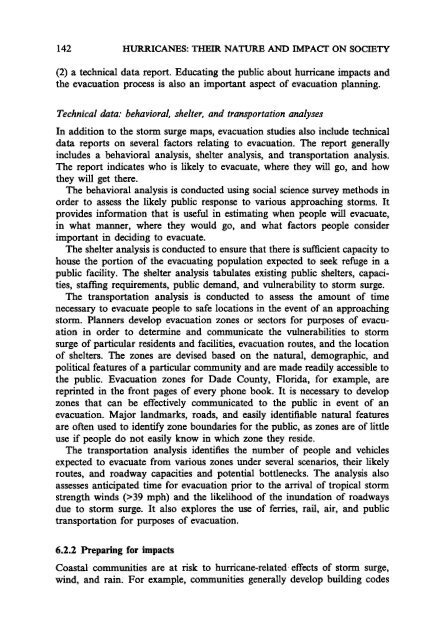Hurricanes: Their Nature and Impacts on Society - Climate Science ...
Hurricanes: Their Nature and Impacts on Society - Climate Science ...
Hurricanes: Their Nature and Impacts on Society - Climate Science ...
Create successful ePaper yourself
Turn your PDF publications into a flip-book with our unique Google optimized e-Paper software.
142<br />
HURRICANES: THEIR NATURE AND IMPACT ON SOCffiTY<br />
(2) a technical data report. Educating the public about hurricane impacts <str<strong>on</strong>g>and</str<strong>on</strong>g><br />
the evacuati<strong>on</strong> process is also an important aspect of evacuati<strong>on</strong> planning.<br />
Technical data: behavioral, shelter, <str<strong>on</strong>g>and</str<strong>on</strong>g> transportati<strong>on</strong> analyses<br />
In additi<strong>on</strong> to the storm surge maps, evacuati<strong>on</strong> studies also include technical<br />
data reports <strong>on</strong> several factors relating to evacuati<strong>on</strong>. The report generally<br />
includes a behavioral analysis, shelter analysis, <str<strong>on</strong>g>and</str<strong>on</strong>g> transportati<strong>on</strong> analysis.<br />
The report indicates who is likely to evacuate, where they will go, <str<strong>on</strong>g>and</str<strong>on</strong>g> how<br />
they will get there.<br />
The behavioral analysis is c<strong>on</strong>ducted using social science survey methods in<br />
order to assess the likely public resp<strong>on</strong>se to various approaching storms. It<br />
provides informati<strong>on</strong> that is useful in estimating when people will evacuate,<br />
in what manner, where they would go, <str<strong>on</strong>g>and</str<strong>on</strong>g> what factors people c<strong>on</strong>sider<br />
important in deciding to evacuate.<br />
The shelter analysis is c<strong>on</strong>ducted to ensure that there is sufficient capacity to<br />
house the porti<strong>on</strong> of the evacuating populati<strong>on</strong> expected to seek refuge in a<br />
public facility. The shelter analysis tabulates existing public shelters, capacities,<br />
staffing requirements, public dem<str<strong>on</strong>g>and</str<strong>on</strong>g>, <str<strong>on</strong>g>and</str<strong>on</strong>g> vulnerability to storm surge.<br />
The transportati<strong>on</strong> analysis is c<strong>on</strong>ducted to assess the amount of time<br />
necessary to evacuate people to safe locati<strong>on</strong>s in the event of an approaching<br />
storm. Planners develop evacuati<strong>on</strong> z<strong>on</strong>es or sectors for purposes of evacuati<strong>on</strong><br />
in order to determine <str<strong>on</strong>g>and</str<strong>on</strong>g> communicate the vulnerabilities to storm<br />
surge of particular residents <str<strong>on</strong>g>and</str<strong>on</strong>g> facilities, evacuati<strong>on</strong> routes, <str<strong>on</strong>g>and</str<strong>on</strong>g> the locati<strong>on</strong><br />
of shelters. The z<strong>on</strong>es are devised based <strong>on</strong> the natural, demographic, <str<strong>on</strong>g>and</str<strong>on</strong>g><br />
political features of a particular community <str<strong>on</strong>g>and</str<strong>on</strong>g> are made readily accessible to<br />
the public. Evacuati<strong>on</strong> z<strong>on</strong>es for Dade County, Florida, for example, are<br />
reprinted in the fr<strong>on</strong>t pages of every ph<strong>on</strong>e book. It is necessary to develop<br />
z<strong>on</strong>es that can be effectively communicated to the public in event of an<br />
evacuati<strong>on</strong>. Major l<str<strong>on</strong>g>and</str<strong>on</strong>g>marks, roads, <str<strong>on</strong>g>and</str<strong>on</strong>g> easily identifiable natural features<br />
are often used to identify z<strong>on</strong>e boundaries for the public, as z<strong>on</strong>es are of little<br />
use if people do not easily know in which z<strong>on</strong>e they reside.<br />
The transportati<strong>on</strong> analysis identifies the number of people <str<strong>on</strong>g>and</str<strong>on</strong>g> vehicles<br />
expected to evacuate from various z<strong>on</strong>es under several scenarios, their likely<br />
routes, <str<strong>on</strong>g>and</str<strong>on</strong>g> roadway capacities <str<strong>on</strong>g>and</str<strong>on</strong>g> potential bottlenecks. The analysis also<br />
assesses anticipated time for evacuati<strong>on</strong> prior to the arrival of tropical storm<br />
strength winds (>39 mph) <str<strong>on</strong>g>and</str<strong>on</strong>g> the likelihood of the inundati<strong>on</strong> of roadways<br />
due to storm surge. It also explores the use of ferries, rail, air, <str<strong>on</strong>g>and</str<strong>on</strong>g> public<br />
transportati<strong>on</strong> for purposes of evacuati<strong>on</strong>.<br />
6.2.2 Preparing for impacts<br />
Coastal communities are at risk to hurricane-related effects of st<strong>on</strong>n surge,<br />
wind, <str<strong>on</strong>g>and</str<strong>on</strong>g> rain. For example, communities generally develop building codes














